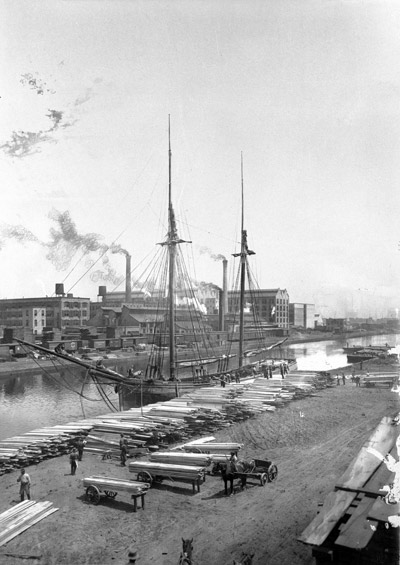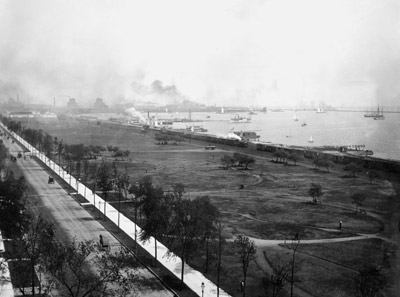Centennial Fountain

Back to Centennial Fountain
Back to Centennial Fountain
One of the busiest harbors
In 1871, more ships docked in the Chicago River than at the ports of New York, Philadelphia, Baltimore, San Francisco, Charleston, and Mobile combined. Some were passing through, carrying cargo to markets along the Mississippi River and Gulf of Mexico. But most would transfer their cargo to trains or river boats before setting out again on Lake Michigan. For the shipping industry, the river provided protection from storms and strong currents and a place to hole up when ice patches made the lake unnavigable in the winter.
For the city and its residents, the Chicago River brought industry. First came lumber yards and graineries. Soon the river was lined with hog feed lots, slaughter houses, distilleries, tanneries, brick yards, furniture factories, and dyeing companies. Train tracks going right up to the river banks made it faster and cheaper to move materials through Chicago than any other city in the region. In 1889, the Chicago Harbor handled 11 million tons of cargo and joined the ranks of London, Hamburg, and New York as one of the greatest ports in the world.
Ironically, the success of the Chicago Harbor was ultimately its downfall. By the end of the 19th century, the river had become so congested with docks that it couldn't hold all the boats that wanted to move through it. And as wooden shipping vessels were replaced with larger steel ones, the river proved too difficult to navigate. Some officials proposed moving the city's harbor to the downtown shoreline of Lake Michigan, near where DuSable Harbor and Navy Pier are now. Residents, though, favored plans to turn the lakefront into public land, and commercial traffic was eventually redirected to South Chicago, Milwaukee, and Waukegan.
For the city and its residents, the Chicago River brought industry. First came lumber yards and graineries. Soon the river was lined with hog feed lots, slaughter houses, distilleries, tanneries, brick yards, furniture factories, and dyeing companies. Train tracks going right up to the river banks made it faster and cheaper to move materials through Chicago than any other city in the region. In 1889, the Chicago Harbor handled 11 million tons of cargo and joined the ranks of London, Hamburg, and New York as one of the greatest ports in the world.
Ironically, the success of the Chicago Harbor was ultimately its downfall. By the end of the 19th century, the river had become so congested with docks that it couldn't hold all the boats that wanted to move through it. And as wooden shipping vessels were replaced with larger steel ones, the river proved too difficult to navigate. Some officials proposed moving the city's harbor to the downtown shoreline of Lake Michigan, near where DuSable Harbor and Navy Pier are now. Residents, though, favored plans to turn the lakefront into public land, and commercial traffic was eventually redirected to South Chicago, Milwaukee, and Waukegan.

